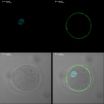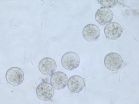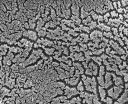(Press-News.org) Researchers at the Wellcome Trust Sanger Institute have discovered interacting proteins on the surface of the sperm and the egg essential to begin mammalian life. These proteins, which allow the sperm and egg to recognize one another, offer new paths towards improved fertility treatments and the development of new contraceptives.
Fertilisation occurs when an egg and a sperm recognise each other and fuse together to form an embryo. The Izumo protein displayed on the sperm that recognises the egg was identified in 2005 by Japanese researchers who named it Izumo, after a Japanese marriage shrine, but its mate on the egg has remained a mystery. That is until now.
The team identified a single protein that paired with Izumo and is necessary for fertilisation. The protein is named Juno after the Roman Goddess of fertility and marriage.
"We have solved a long-standing mystery in biology by identifying the molecules displayed on all sperm and egg that must bind each other at the moment we were conceived," says Dr Gavin Wright, senior author from the Sanger Institute. "Without this essential interaction, fertilisation just cannot happen. We may be able to use this discovery to improve fertility treatments and develop new contraceptives."
The scientists created an artificial version of the Izumo protein and used this to identify binding partners on the surface of the egg. Using this approach, they discovered that Izumo on the sperm interacted with Juno on the surface of the egg to initiate fertilisation.
The team developed mice that lacked the Juno protein on the surface of their eggs. These mice were infertile and their eggs did not fuse with normal sperm, highlighting that the Juno protein is essential for fertility in female mice. In the same way, male mice lacking the Izumo protein are also infertile, highlighting its essential role in male fertility.
"The Izumo-Juno pairing is the first known essential interaction for sperm-egg recognition in any organism," says Dr Enrica Bianchi, first author from the Wellcome Trust Sanger Institute. "The binding of the two proteins is very weak, which probably explains why this has remained a mystery until now.
"Previous work in the laboratory led us to expect the interaction to be weak, and this then guided the design of our experiments, and, after a lot of effort, it finally worked."
The team found that after the initial fertilisation step, there is a sudden loss of the Juno protein from the surface of the egg, becoming virtually undetectable after just 40 minutes. This may explain why the egg, once fertilised by the first sperm cell, shuts down its ability to recognise further sperm. This prevents the formation of embryos with more than one sperm cell that would otherwise have too many chromosomes and die.
The team is now screening infertile women to understand whether defects in the Juno receptor are a cause of infertility. If it is, then a simple genetic screening test could help inform the appropriate treatment for women struggling to conceive naturally by reducing the expense and stress often involved in assisted fertility treatments.
INFORMATION:
Notes to Editors
Publication Details
Enrica Bianchi, Brendan Doe, David Goulding & Gavin J. Wright. (2014) 'Juno is the egg Izumo receptor and is essential for mammalian fertilization'
Advanced online publication in Nature. Doi:10.1038/nature13203
Funding
This work was supported by the Wellcome Trust
Participating Centres
Cell Surface Signalling Laboratory, Wellcome Trust Sanger Institute, Hinxton, Cambridge, CB10 1SA, UK.
Mouse Production Team, Wellcome Trust Sanger Institute, Hinxton, Cambridge, CB10 1SA, UK.
Electron and Advanced Light Microscopy Suite, Wellcome Trust Sanger Institute, Hinxton, Cambridge, CB10 1SA, UK.
Wellcome Trust Sanger Institute, Hinxton, Cambridge, CB10 1SA, UK.
Selected Websites
The Wellcome Trust Sanger Institute is one of the world's leading genome centres. Through its ability to conduct research at scale, it is able to engage in bold and long-term exploratory projects that are designed to influence and empower medical science globally. Institute research findings, generated through its own research programmes and through its leading role in international consortia, are being used to develop new diagnostics and treatments for human disease.
http://www.sanger.ac.uk
The Wellcome Trust is a global charitable foundation dedicated to achieving extraordinary improvements in human and animal health. We support the brightest minds in biomedical research and the medical humanities. Our breadth of support includes public engagement, education and the application of research to improve health. We are independent of both political and commercial interests.
http://www.wellcome.ac.uk
Contact details
Don Powell Media Manager
Wellcome Trust Sanger Institute
Hinxton, Cambridge, CB10 1SA, UK
Tel +44 (0)1223 496 928
Mobile +44 (0)7753 7753 97
Email press.office@sanger.ac.uk
End of Notes to Editors
Sperm meets egg: Protein essential for fertilization discovered
First vital step in fertilization between sperm and egg discovered
2014-04-16
ELSE PRESS RELEASES FROM THIS DATE:
Hide and seek: Revealing camouflaged bacteria
2014-04-16
A research team at the Biozentrum of the University of Basel has discovered an protein family that plays a central role in the fight against the bacterial pathogen Salmonella within the cells. The so called interferon-induced GTPases reveal and eliminate the bacterium's camouflage in the cell, enabling the cell to recognize the pathogen and to render it innocuous. The findings are published in the current issue of the science magazine Nature.
Bacteria have developed countless strategies to hide themselves in order to evade attack by the immune system. In the body, Salmonella ...
Why your nose can be a pathfinder
2014-04-16
Waves in your brain make smells stick to your memories and inner maps.
When I was a child I used to sit in my grandfather's workshop, playing with wood shavings. Freshly shaven wood has a distinct smell of childhood happiness, and whenever I get a whiff of that scent my brain immediately conjures up images of my grandfather at his working bench, the heat from the fireplace and the dog next to it.
Researchers at the Kavli Institute for Systems Neuroscience have recently discovered the process behind this phenomenon. The brain, it turns out, connects smells to memories ...
Rice U. study: Performance measures for CEOs vary greatly
2014-04-16
HOUSTON – (April 16, 2014) – As companies file their annual proxy statements with the U.S. Securities and Exchange Commission (SEC) this spring, a new study by Rice University and Cornell University shows just how S&P 500 companies have tied CEO compensation to performance. The study found large variations in the choice of performance measures, and the researchers said that companies tend to choose measures that are informative of CEO actions.
"On average, firms rely mostly on accounting-based performance measures, among which they put heavier weights on income measures, ...
Progress in the fight against quantum dissipation
2014-04-16
Scientists at Yale have confirmed a 50-year-old, previously untested theoretical prediction in physics and improved the energy storage time of a quantum switch by several orders of magnitude. They report their results in the April 17 issue of the journal Nature.
High-quality quantum switches are essential for the development of quantum computers and the quantum internet — innovations that would offer vastly greater information processing power and speed than classical (digital) computers, as well as more secure information transmission.
"Fighting dissipation is one ...
Why interest is crucial to your success
2014-04-16
DURHAM, N.C. -- Maintaining an interest in the goals you pursue can improve your work and reduce burnout, according to research from Duke University.
"Our research shows that interest is important in the process of pursuing goals. It allows us to perform at high levels without wearing out," said Paul O'Keefe, who conducted the studies as a doctoral student in Duke University's Department of Psychology & Neuroscience, along with associate professor Lisa Linnenbrink-Garcia. "This suggests that interest matters more than we suspected."
The studies, which appear online ...
Dartmouth-led study shows air temperature influenced African glacial movements
2014-04-16
Changes in air temperature, not precipitation, drove the expansion and contraction of glaciers in Africa's Rwenzori Mountains at the height of the last ice age, according to a Dartmouth-led study funded by the National Geographic Society and the National Science Foundation.
The results – along with a recent Dartmouth-led study that found air temperature also likely influenced the fluctuating size of South America's Quelccaya Ice Cap over the past millennium -- support many scientists' suspicions that today's tropical glaciers are rapidly shrinking primarily because of ...
Scientists unlock secrets of protein produced by disease-causing fungus
2014-04-16
SAN ANTONIO, Texas (April 16, 2014) — A team that includes scientists from the School of Medicine at The University of Texas Health Science Center at San Antonio, Johns Hopkins University and St. Mary's University reported the structure of a protein that helps a common fungus to infect the body.
The fungal pathogen Candida albicans causes yeast infections, diaper rashes and oral thrush, and is the most common fungal pathogen to infect humans. It can also cause a life-threatening infection of the blood called disseminated candidiasis.
"In this study, we determined the ...
Vanderbilt researchers discover how intestinal cells build nutrient-absorbing surface
2014-04-16
The "brush border" – a densely packed array of finger-like projections called microvilli – covers the surfaces of the cells that line our intestines.
Vanderbilt University researchers have now discovered how intestinal cells build this specialized structure, which is critical for absorbing nutrients and defending against pathogens. The findings, published April 10 in the journal Cell, reveal a role for adhesion molecules in brush border assembly and increase our understanding of intestinal pathologies associated with inherited and infectious diseases.
Pathogens that destroy ...
Surveillance colonoscopy recommendations for average-risk patients with 1 to 2 small polyps consistent with guidelines
2014-04-16
DOWNERS GROVE, Ill. – April 16, 2014 – According to a new study, endoscopists' recommendations for timing of surveillance colonoscopy in average-risk patients with one to two small polyps are consistent with guideline recommendations in about 90 percent of cases. This may be an appropriate target for quality indicators. This is the first multicenter endoscopic database study to quantify adherence to guidelines for timing of repeat colonoscopy after one to two small polyps are found during screening colonoscopy in average-risk patients. The study appears in the April issue ...
Scientists capture ultrafast snapshots of light-driven superconductivity
2014-04-16
A new study pins down a major factor behind the appearance of superconductivity—the ability to conduct electricity with 100 percent efficiency—in a promising copper-oxide material.
Scientists used carefully timed pairs of laser pulses at SLAC National Accelerator Laboratory's Linac Coherent Light Source (LCLS) to trigger superconductivity in the material and immediately take x-ray snapshots of its atomic and electronic structure as superconductivity emerged.
They discovered that so-called "charge stripes" of increased electrical charge melted away as superconductivity ...
LAST 30 PRESS RELEASES:
Making lighter work of calculating fluid and heat flow
Normalizing blood sugar can halve heart attack risk
Lowering blood sugar cuts heart attack risk in people with prediabetes
Study links genetic variants to risk of blinding eye disease in premature infants
Non-opioid ‘pain sponge’ therapy halts cartilage degeneration and relieves chronic pain
AI can pick up cultural values by mimicking how kids learn
China’s ecological redlines offer fast track to 30 x 30 global conservation goal
Invisible indoor threats: emerging household contaminants and their growing risks to human health
Adding antibody treatment to chemo boosts outcomes for children with rare cancer
Germline pathogenic variants among women without a history of breast cancer
Tanning beds triple melanoma risk, potentially causing broad DNA damage
Unique bond identified as key to viral infection speed
Indoor tanning makes youthful skin much older on a genetic level
Mouse model sheds new light on the causes and potential solutions to human GI problems linked to muscular dystrophy
The Journal of Nuclear Medicine ahead-of-print tip sheet: December 12, 2025
Smarter tools for peering into the microscopic world
Applications open for funding to conduct research in the Kinsey Institute archives
Global measure underestimates the severity of food insecurity
Child survivors of critical illness are missing out on timely follow up care
Risk-based vs annual breast cancer screening / the WISDOM randomized clinical trial
University of Toronto launches Electric Vehicle Innovation Ontario to accelerate advanced EV technologies and build Canada’s innovation advantage
Early relapse predicts poor outcomes in aggressive blood cancer
American College of Lifestyle Medicine applauds two CMS models aligned with lifestyle medicine practice and reimbursement
Clinical trial finds cannabis use not a barrier to quitting nicotine vaping
Supplemental nutrition assistance program policies and food insecurity
Switching immune cells to “night mode” could limit damage after a heart attack, study suggests
URI-based Global RIghts Project report spotlights continued troubling trends in worldwide inhumane treatment
Neutrophils are less aggressive at night, explaining why nighttime heart attacks cause less damage than daytime events
Menopausal hormone therapy may not pose breast cancer risk for women with BRCA mutations
Mobile health tool may improve quality of life for adolescent and young adult breast cancer survivors
[Press-News.org] Sperm meets egg: Protein essential for fertilization discoveredFirst vital step in fertilization between sperm and egg discovered






